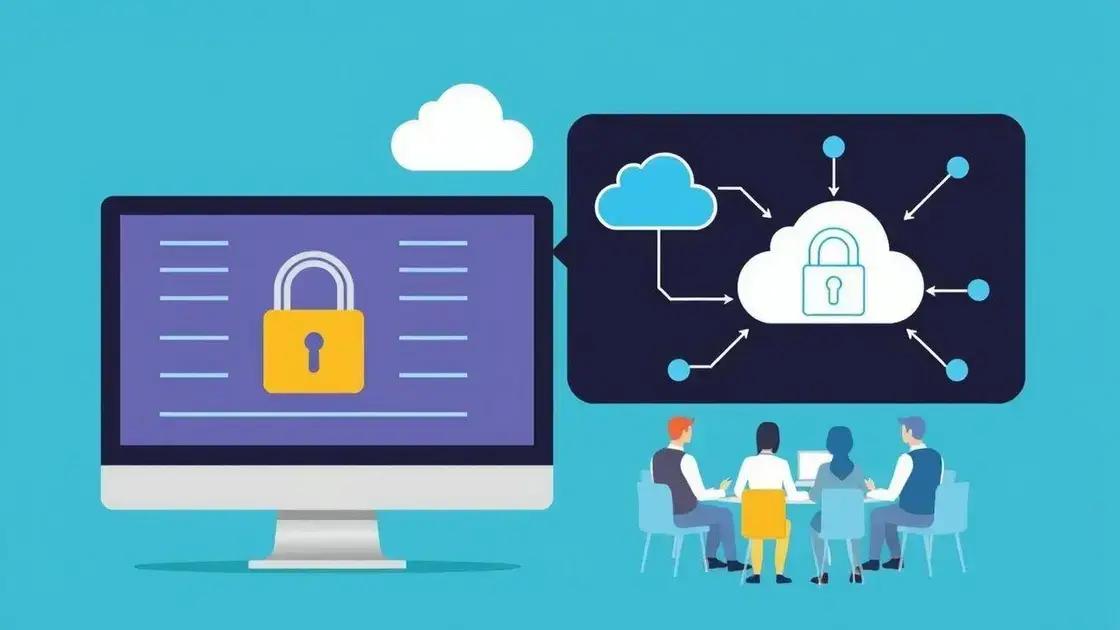Base cybersecurity threats 2025: are you ready?

Preparing your organization for future threats involves conducting regular risk assessments, providing ongoing employee training, implementing advanced technologies, and developing a robust incident response plan.
Base cybersecurity threats 2025 present new challenges that could impact every aspect of our digital lives. Have you considered how prepared you are to face these evolving threats? In this article, we will dive into the landscape of cybersecurity as we approach 2025.
Current trends in cybersecurity threats
The world of cybersecurity is constantly changing. Understanding the current trends in cybersecurity threats helps individuals and organizations stay prepared. Recent events have shown that threats are no longer just targeted at big corporations; even small businesses face risks.
As we approach 2025, one major trend is the rise of ransomware attacks. These attacks hold organizations hostage, demanding payment to release their data. In the past year, many high-profile companies have been hit, and the demands have skyrocketed. Companies need to invest in protecting their systems and educating employees on how to recognize these threats.
Increased use of AI in cyberattacks
Another alarming trend is the use of artificial intelligence (AI) in cyberattacks. Cybercriminals are leveraging AI to develop sophisticated methods for breaching security systems. This technology enables them to automate attacks and find vulnerabilities faster than ever.
- Deepfake technology makes phishing attempts more convincing.
- AI helps identify weak points in a network.
- Automated bots can launch attacks on a massive scale.
Yet, it’s not just AI that we need to be worried about. The Internet of Things (IoT) devices are another significant factor in the changing landscape of threats. As more devices become connected, the attack surface increases. Minor devices, like smart thermostats, can be exploited as entry points into larger networks.
Furthermore, cloud security is becoming a hot topic. As companies move their data to the cloud, they need to ensure they understand the security measures offered by their providers. Issues such as misconfigured security settings can lead to significant data breaches.
Challenges posed by remote work
The increase in remote work has also changed the game. More employees are using personal devices and unsecured networks, making it easier for hackers to access sensitive information. Organizations must take proactive steps to educate their staff about safe practices while working from home.
Overall, the cybersecurity threat landscape is evolving rapidly. Those who fail to adapt may find themselves vulnerable to attacks. Continuous learning and investing in robust security measures are crucial to staying ahead.
Top vulnerabilities to watch in 2025
As we look toward 2025, identifying the top vulnerabilities is crucial for effective cybersecurity planning. Every year, new weaknesses emerge, and familiar ones evolve, presenting unique challenges.
One significant vulnerability is software misconfigurations. Often, organizations overlook basic security settings, leading to easy entry points for hackers. Regular audits can help identify and fix these issues.
Insecure APIs
Another critical area to focus on is insecure APIs. As businesses increasingly rely on APIs to connect various systems, weaknesses in these interfaces can expose sensitive data. It’s essential to enforce strict security protocols around these access points.
- Implement strong authentication measures.
- Regularly test API security to identify flaws.
- Keep API documentation up to date.
Furthermore, the rise of remote work increases risks related to endpoint security. Employees accessing corporate systems from home often use personal devices that lack robust security measures. This creates vulnerabilities that hackers can exploit.
Supply chain weaknesses
Supply chain vulnerabilities also require attention. Cybercriminals often target third-party vendors to gain access to larger organizations. Ensuring that all partners follow strict security guidelines is a critical step in mitigating these risks.
Finally, organizations should prepare for an increase in attacks targeting cloud environments. As more businesses migrate to the cloud, understanding the shared responsibility model is vital. Companies must take proactive steps to configure their cloud settings correctly and implement strong encryption practices.
Staying informed about these vulnerabilities will help organizations defend against potential attacks. By prioritizing these areas, companies can strengthen their defenses and safeguard their data more effectively.
Strategies for protecting your data

Data protection is critical in today’s digital landscape. Understanding effective strategies for protecting your data can help safeguard personal and business information from cyber threats.
One key approach is to implement strong password policies. Encouraging users to create complex passwords and change them regularly can significantly reduce the risk of unauthorized access. Using password managers can also help keep track of these complex passwords.
Regular Software Updates
Another essential strategy is to keep all software up to date. Cybercriminals often exploit known vulnerabilities in outdated software. Regularly patching systems can close these gaps, making it harder for attackers to succeed.
- Set automatic updates for operating systems and applications.
- Ensure antivirus software is active and updated regularly.
- Backup data frequently to protect against loss.
Moreover, organizations should prioritize employee training on data security practices. Providing regular training sessions can help employees recognize phishing attempts and understand the importance of data protection. An informed team is less likely to fall victim to cyber attacks.
Data Encryption
Implementing data encryption is another powerful way to protect sensitive information. By encrypting data at rest and in transit, even if a breach occurs, the stolen data remains unreadable without the encryption key. Businesses should consider utilizing encrypted communication channels for sharing sensitive information.
Additionally, establish access controls to limit who can view and edit sensitive data. Access control ensures that only authorized personnel can interact with vital information, reducing the risk of insider threats.
Cloud-based storage solutions also offer integrated security features. It’s important to choose providers that prioritize security and offer options for multi-factor authentication to further enhance protection.
By employing these strategies, individuals and businesses can create a robust defense against potential data breaches, ensuring that their information remains secure.
Emerging technologies in cybersecurity
The landscape of emerging technologies in cybersecurity is evolving rapidly. Staying updated with these advancements is essential for protecting sensitive data and systems.
One of the most significant developments is the use of artificial intelligence (AI) and machine learning. These technologies can analyze vast amounts of data to identify threats more accurately and faster than humans. By using AI, organizations can improve their incident response times and predict potential vulnerabilities.
Blockchain technology
Another innovative approach is the application of blockchain technology. This decentralized system can enhance security by making data tampering extremely difficult. It allows for secure and transparent transactions, which is especially beneficial for industries like finance and healthcare.
- Blockchain provides a secure method for data sharing.
- It helps in proving the authenticity of transactions.
- Blockchain can reduce identity theft risks.
Furthermore, the implementation of quantum computing is expected to change cybersecurity dramatically. While still in its early stages, quantum computing could break current encryption methods. Therefore, researchers are already exploring quantum-resistant cryptography to prepare for this future.
Zero trust architecture
Adopting a zero trust architecture is another pivotal change. This model assumes that threats could be both external and internal, requiring strict verification of every user and device. In a zero trust environment, security measures are constantly evaluated, ensuring that access is granted only when necessary.
Additionally, automation tools are gaining traction. With the increasing number of security alerts, automated systems can help prioritize responses. This saves time and allows security teams to focus on more complex issues.
Incorporating these emerging technologies allows organizations to enhance their security postures. Staying informed and embracing these advancements will help combat new threats as they arise.
Preparing your organization for future threats
Preparing your organization for future threats is essential in today’s rapidly changing digital landscape. To stay ahead, companies need to adopt proactive measures and strategies that enhance their cybersecurity posture.
One way to start is by conducting regular risk assessments. This process helps identify potential vulnerabilities and gauge the effectiveness of existing security measures. By assessing risks periodically, organizations can adapt their defenses to address new and evolving threats.
Employee Training and Awareness
Another vital step is to provide ongoing employee training. Employees are often the first line of defense against cyber threats. Regular cybersecurity awareness programs can help staff recognize phishing attempts and understand safe internet practices.
- Encourage staff to report suspicious emails.
- Implement simulated phishing tests to improve response skills.
- Highlight the importance of using strong passwords and multi-factor authentication.
Technology implementation plays a crucial role as well. Investing in advanced security solutions, such as intrusion detection systems and endpoint protection tools, can significantly enhance protection. Furthermore, utilizing security analytics can help organizations detect threats before they escalate.
Developing an Incident Response Plan
Another critical aspect is creating a robust incident response plan. This plan should detail steps to follow in the event of a security breach. Having a well-prepared response team ensures that your organization can react swiftly, minimizing damage and recovery time.
Additionally, establishing partnerships with cybersecurity experts can be beneficial. These professionals can provide valuable insights and support during critical situations. Outside expertise can help in developing better strategies, and staying current with emerging threats.
Lastly, organizations should cultivate a culture of cybersecurity. By prioritizing security in their daily operations, businesses lay the groundwork for a secure future. Sharing knowledge and encouraging employee engagement fosters a proactive environment where cybersecurity is everyone’s responsibility.
FAQ – Frequently Asked Questions about Preparing for Future Cybersecurity Threats
Why is conducting risk assessments important?
Conducting risk assessments helps identify vulnerabilities in your organization, allowing you to address them proactively before they can be exploited by cybercriminals.
How often should employee training be conducted?
Employee training should be conducted regularly, ideally every few months, to keep staff informed about the latest cybersecurity threats and safe practices.
What role do advanced technologies play in cybersecurity?
Advanced technologies, such as AI and machine learning, enhance cybersecurity by quickly identifying and responding to threats, thus improving the overall security posture of an organization.
What is an incident response plan?
An incident response plan is a documented strategy that outlines the steps to take when a security breach occurs, helping to minimize damage and facilitate recovery.





